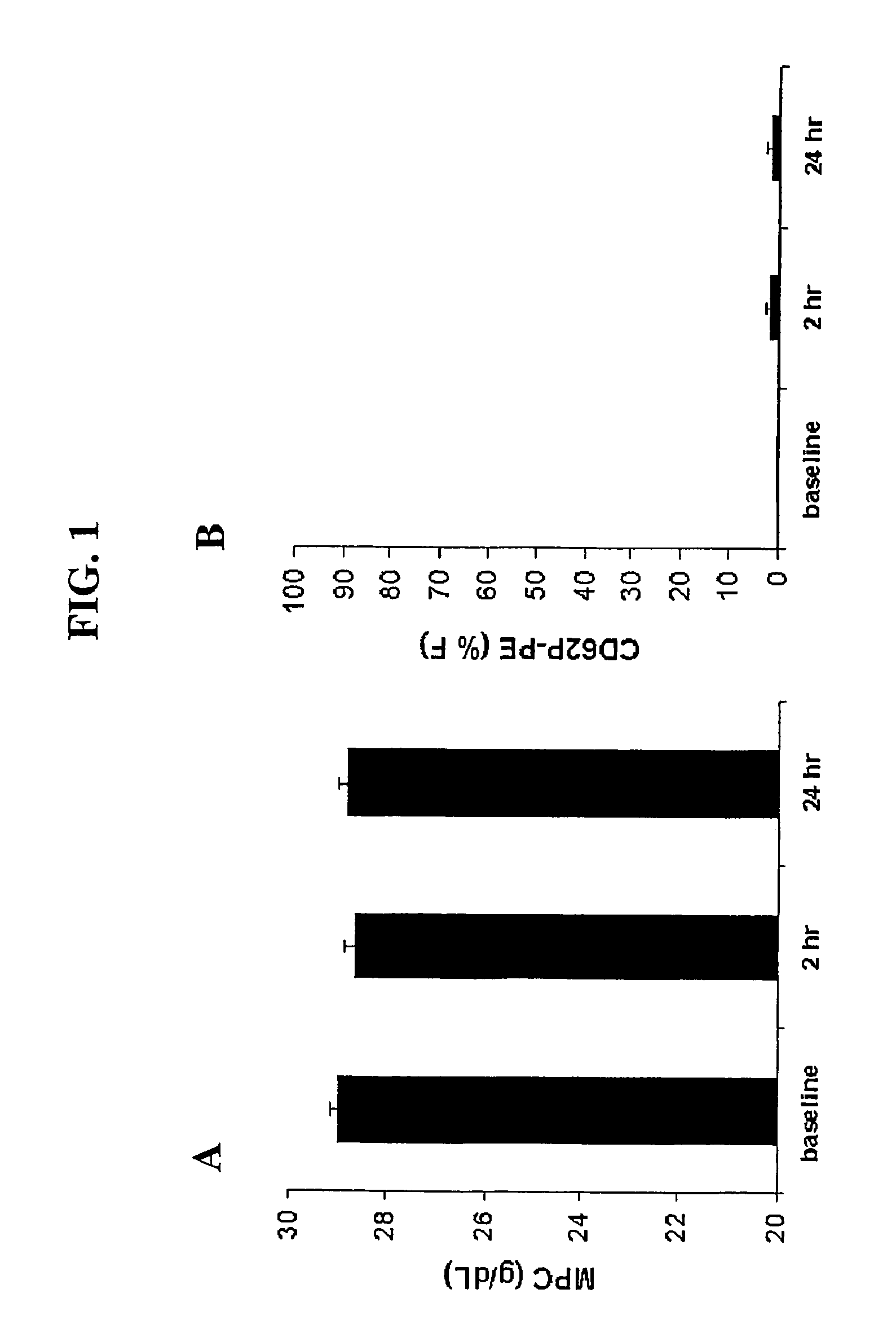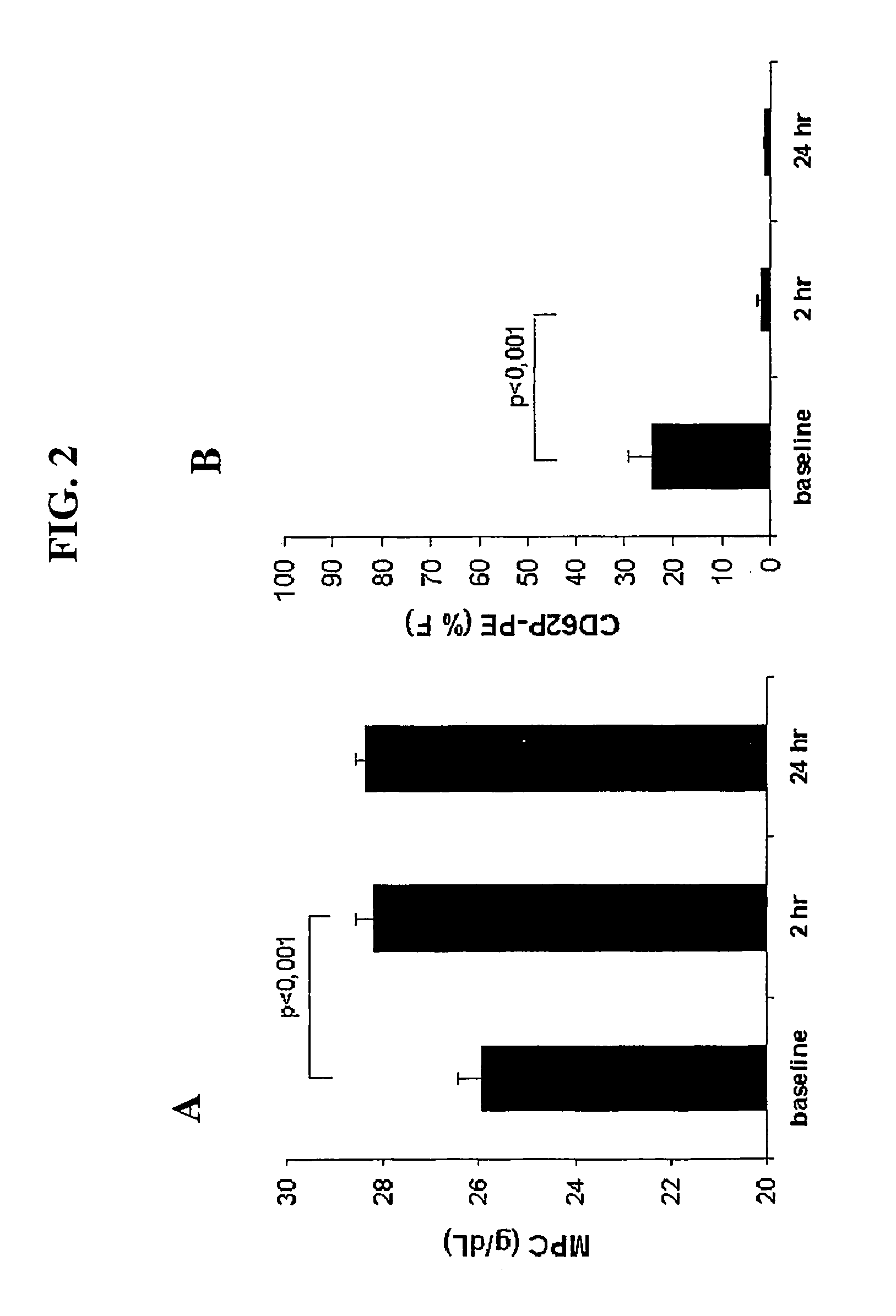Methods for monitoring patients for efficacy of an antiplatelet therapy regimen
a technology of antiplatelet therapy and monitoring method, which is applied in the direction of instruments, biochemical equipment and processes, material analysis, etc., can solve the problems of high labor intensity, high clinical risk of thrombosis or bleeding, artificial in vitro activation of platelets, etc., and achieve the effect of early apprehension of susceptibility
- Summary
- Abstract
- Description
- Claims
- Application Information
AI Technical Summary
Problems solved by technology
Method used
Image
Examples
example 1
Basal Platelet Activation Levels in Patients with Acute Coronary Syndrome
[0051]The following study determined a relationship between platelet activation and elevated baseline platelet-activation markers in patients with acute coronary syndrome (e.g., UA / NSTEMI). Baseline activation status as measured by MPC is predictive of future platelet activity and vascular complications in the patients. The baseline activation status as measured by MPC therefore also identifies individual patients who would be most likely to benefit from an anti-platelet regimen.
[0052]Blood was drawn from patients before and after anti-platelet therapy and angioplasty. Platelet activation was evaluated by expression of CD62P (P-selectin) measured by flow cytometry and by the platelet density parameter, mean platelet component (MPC) concentration measured on the ADVIA 120 Hematology System. MPC drops with platelet activation and is associated with decreased platelet density linked to platelet degranulation. The ...
example 2
Variability in Platelet Response to Anti-Platelet Therapies in Patients with Acute Coronary Syndrome and Undergoing Angioplasty
[0074]This study established the clinical usefulness of a novel method for evaluating platelet activation and the variability in platelet response to platelet antagonist therapy in patients undergoing percutaneous transluminal coronary angioplasty. It also illustrated the use of platelet-activation markers to define high-risk patients and to monitor the platelet response of individual patients to anti-platelet therapies, either concurrently with angioplasty or alone.
[0075]Patients. A total of 44 patients who underwent elective percutaneous coronary angioplasty and stenting were evaluated Patients were enrolled in the study after informed consent had been obtained. Their baseline variables including age, gender, smoking history and medication were documented. The treatments were assigned based on the angiographic characteristics. Patients with presence of thr...
example 3
Mean Platelet Component as a Biomarker for Risk Stratification for Patients with Vascular Conditions
[0093]Novel serum biomarkers are needed for diagnosis of patients with platelet-affected vascular pathologies, including unstable angina. Decreased levels of MPC are associated with platelet activation and may be a maker for such patients. In the absence of a definitive biomarker, diagnosis is made on clinical grounds. Untreated patients with unstable angina have a. high likelihood of death, myocardial infarction, or need for urgent revascularization in the very near term (for example, within less than six months). The following study was designed to establish that for patients who present to the hospital emergency department with chest pain, a low mean platelet component is associated with increased risk for adverse events. The study also investigated the association between BNP expression and increased risk.
[0094]Materials and methods. Blood was collected at presentation into tubes ...
PUM
| Property | Measurement | Unit |
|---|---|---|
| fluorescence flow cytometry | aaaaa | aaaaa |
| fluorescence measurements | aaaaa | aaaaa |
| stability | aaaaa | aaaaa |
Abstract
Description
Claims
Application Information
 Login to view more
Login to view more - R&D Engineer
- R&D Manager
- IP Professional
- Industry Leading Data Capabilities
- Powerful AI technology
- Patent DNA Extraction
Browse by: Latest US Patents, China's latest patents, Technical Efficacy Thesaurus, Application Domain, Technology Topic.
© 2024 PatSnap. All rights reserved.Legal|Privacy policy|Modern Slavery Act Transparency Statement|Sitemap



